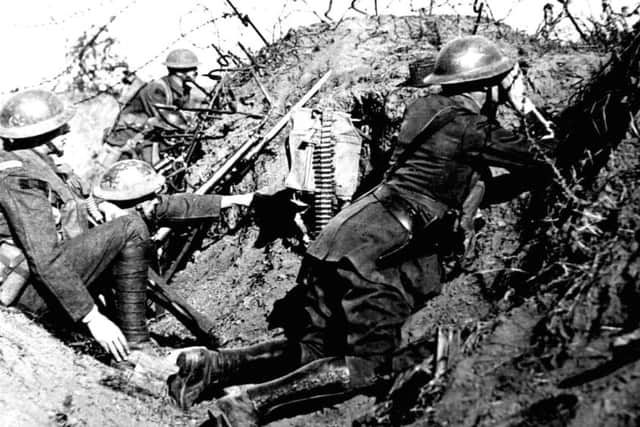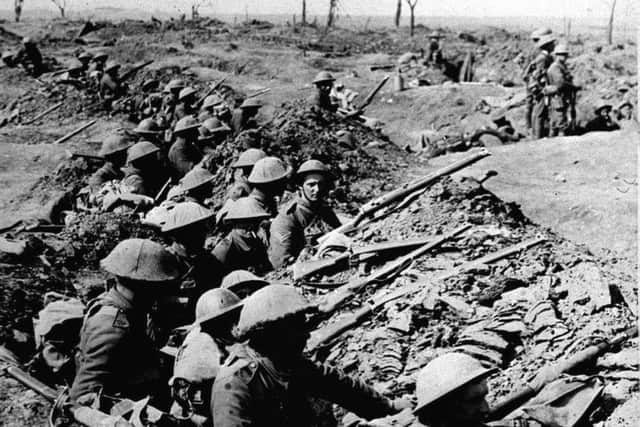The Battle of the Somme: The British Army's darkest day


as the countdown to 7.30am drew closer, a frisson of tension and fear rippled through the massed ranks of British soldiers as they waited in their filthy trenches for the sound of whistles being blown - the signal for them to go over the top.
With their bayonets fixed, some let their thoughts wander to loved ones back home, others took a swig of rum or tried to focus their minds on the task ahead, shutting out any thoughts of their possible impending demise.
Advertisement
Hide AdAdvertisement
Hide AdBut none of those men who clambered up the ladders and staggered out into the honeyed light on the morning of July 1, 1916, could possibly have known what was to follow.


Not only was the Battle of the Somme the single most catastrophic day in the history of the British Army, it left whole communities in mourning and is now seared into the national consciousness - a symbol of the carnage and horror of the First World War.
In all some 120,000 men went over the top on that fine summer’s day along a 16-mile front of marshy flatlands in northern France bisected by the River Somme.
A significant proportion of those were from Lord Kitchener’s Pals battalions who had responded so unflinchingly to his rallying cry two years earlier after war broke out. For many of them this would be their first, and last, battle.
Advertisement
Hide AdAdvertisement
Hide AdUnits such as the Sheffield City Battalion, the Leeds, Bradford and Barnsley Pals and the Grimsby Chums, perished on the idealistic notion that they were made of the “right stuff”, every bit as good as the men and boys from the neighbouring town or district.


By nightfall on that first day the number of men killed stood at 19,240, almost enough to fill Headingley cricket ground - a high price to pay for gaining just three square miles of territory.
Some battalions such as the 10th West Yorkshires, which recruited men from in and around Harrogate and Leeds, were all but wiped out in a matter of hours. The West Yorkshires also had the grim distinction of losing more men during the first day on the Somme than any other battalion - of the 1,050 that went into battle, 710 became casualties, 60 per cent of whom were killed.
Many didn’t make it out of their own trenches, most never got further than 100 yards. For every yard of the 16 mile front between Gommecourt and Montauban there were two casualties in the first 24 hours.
Advertisement
Hide AdAdvertisement
Hide AdAccording to Edward Spiers, Professor of Strategic Studies at the University of Leeds, a fifth of the British soldiers involved on that first day came from Yorkshire battalions. “Out of 57,470 casualties overall, around 9,000 came from Yorkshire which was considerably more than any other county or region in the country.”


Compare these dreadful statistics to the British losses at other notable battles in our history - 8,400 at Waterloo, 12,000 over 11 days fighting at El Alamein and 255 in the Falklands campaign - and it perhaps explains why a century on the Somme still looms large in our collective consciousness.
The widely held view is that the generals were to blame for that calamitous first day, yet it’s worth noting that a high percentage of the casualties were borne by regimental officers.
To understand what went wrong that morning we need to look at why the British launched the offensive in the first place. By the spring of 1916 the French were struggling to contain the Germans as they attempted to smash through to Paris and bring the war to an end.
Advertisement
Hide AdAdvertisement
Hide AdOne of the aims of the British offensive along the Somme was to relieve this pressure. Originally, it was to have been a Franco-British attack, but heavy demands on the French at Verdun meant that for the first time in the war, the British would play the leading role.


The plan, led by the commander-in-chief, Sir Douglas Haig, and Sir Henry Rawlinson, involved a remorseless artillery bombardment ahead of the attack. For seven days and nights 1,500 British guns fired over a million shells on the German lines.
In addition to this 19 mines dug by members of the Royal Engineers were detonated under enemy positions on the morning of the first attack. This, so the top brass believed, would leave the enemy so demoralised that any resistance would be non-existent.
But the Germans had long expected an Allied offensive against their heavily-fortified lines on the Western Front, and despite the ferocity of the bombardment it proved ineffective against such well-trained troops, who were able to retreat into their network of underground bunkers.
Advertisement
Hide AdAdvertisement
Hide AdAlthough the mines took the Germans by surprise the creeping artillery barrage that preceded the infantry attack moved too quickly giving the enemy time to get back into position. Not only that but in many places the barbed wire, which was supposed to have been destroyed by the artillery bombardment, remained intact. So when our young men went over the top into No Man’s Land they walked straight into a murderous hail of gunfire and shrapnel and, as one observer described at the time, were “mown down like meadow grass.”
Speaking to The Yorkshire Post in 1994, George Gledhill, who was the oldest surviving veteran of the Somme, talked lucidly about his memories of that harrowing first day when he saw many of his friends in the 1/5th West Yorkshire Regiment perish. “I never once got hit - I was lucky,” he said. “I made a lot of friends in the army but many of them fell at the Somme. My eldest brother Horace died there.
“On that first day of the battle in July, so many thousands were killed - the poor beggars. It was a horrific place, muddy and littered with dead bodies and animals.


“We were thankfully based further down from the frontline but had to move to the trenches to supply the frontline troops. Despite the carnage we just carried on and did as we were told. That’s all you could do.”
Advertisement
Hide AdAdvertisement
Hide AdBut that hideous first day wasn’t the end of it. In the following weeks and months, the Somme became the graveyard of a generation as the Allies repeatedly sought a breakthrough, while the enemy was ordered to defend every single yard of its front line.
Back in Britain news slowly began to filter through of the scale of the devastation, and where families once looked forward to receiving a letter from their loved ones on the front now they dreaded the sight of the post boy heading in their direction clutching a telegram.
Across towns and cities blinds were drawn, church bells tolled, and local newspapers printed ever growing lists of their local fallen heroes.
By the time the Somme Offensive ground to a halt amidst the squalor, exhaustion and mud in November, more than a million soldiers from the British, German and French armies had either been wounded or killed.
Advertisement
Hide AdAdvertisement
Hide AdThere are some who argue that such high casualty rates were almost inevitable given the size of the armies pitched against one another, and point out that lessons were learned and strategies improved - it was here where tanks were used for the first time - in a conflict that couldn’t be avoided.
For others, though, the Battle of the Somme was nothing but an orgy of slaughter with July 1, 1916, the darkest day in what Ted Hughes called that “huge, senseless war”.
The Somme in numbers
At 7.30am on the morning of July 1, 1916, officers sounded their whistles and the men went “over the top.”
Around 120,000 Allied soldiers fought on the first day of the battle. By the end of that day the number of British casualties stood at 57,470.
Advertisement
Hide AdAdvertisement
Hide AdYorkshire battalions made up 20 per cent of the British forces involved in the action on July 1.
For five months the British and French armies fought the Germans along a 16-mile front.
Sixty per cent of those wounded or killed during the First World War were the victims of artillery.
By the time the Somme offensive ground to a halt in November, more than one million British, French and German soldiers had been killed or wounded.